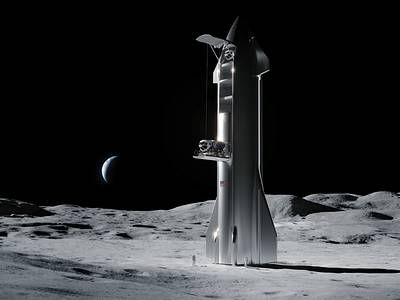
SpaceX NASA CLPS concept, image credit SpaceX

SpaceX NASA CLPS concept, image credit SpaceX
Of the payload categories only Starship can handle the 8,000 - 12,000 kg class. There are bunch of CLPS lander concepts (https://www.nasa.gov/content/draft-concepts-for-commercial-lunar-landers) and they all try to optimize mass and volume of payloads to the lunar surface, and none have a return option, except SpaceX's.
It is a nice render, but seems suboptimal for the mission. While every other lander has little vehicle mass above tanks, engines and legs, SpaceX shows a bunch of mass above tanks, engines and legs. Also, the Starship shell can impede the extraction and positioning of large objects.
If we think a Cargo Starship might cost as little as $50M, it seems that it would be more cost effective to employ a one-way-Starship, with no TPS, header tanks and control fins that ejects its fairing as soon as it is out of the atmosphere. I would also add F9 type landing legs and a crane for offloading a variety of masses, shapes and volumes.
If you assume a launch is $10M and a Cargo Starship is $50M then
I assume
Any Starship landing on the Moon in the CLPS era will need better landing legs with a mass of 5,000 kg total. This adds $5M to the one way Starship cost since there is no reuse.
LEO -> Lunar Surface requires 6000 m/s of DV, Lunar Surface -> Earth requires 1,800 m/s
Cargo Starship regular dry mass is 120,000 kg ... the above CLPS concept adds 5,000 kg for cargo framing and elevator
The mass of the structure above the tanks + fins + TPS + cargo framing and elevator = 35,000 kg
Thus a one way "fairing-less" (with it's own 5,000 kg for cargo framing and crane) = 90,000 kg dry mass.
This lower dry mass also increases the mass to LEO as this fairing is ejected soon after Starship separates some Super Heavy. Starship DV needed to LEO is assumed to be 6,300 m/s after SH separation
Reducing the dry mass of Starship to 90,000 kg increases the payload by about 30,000 kg. This also reduced the cost by 10% so a one-way Starship is back to $50M.
With a 100% refuel (6 more refuel trips) this allows a one way 180,000 kg of payload to the lunar surface (since there now is a 95,000 kg dry mass vs 215,000 kg).
By contrast, the regular Cargo Starship that can be re-used:
It can lift 150,000 kg to LEO ... so a limitation here vs the 180,000 of the one-way version
With a 100% refuel (8 more refuel trips) gives you 180,000 kg in payload + return fuel to the Lunar Surface
But most of the payload + return fuel is return fuel ... leaving maybe only 80,000 kg for payload to the Lunar Surface.
Thus about 2x the mass to surface for a one way fairingless Starship vs a re-usable cargo one (like in the image).
One-way cargo Starship can deliver 180,000 kg for $115M (around $600,000 per metric ton)
Cargo Starships can deliver 80,000 kg is $90M if we assume reuse cost is baked into that $10m per launch
Thus a "fairingless" one way system may be a better value. This value increases if launch costs are more than $10M. It decreases if Starship build costs are more than $50M.
In any case this offers a far ... far better value than the next best system, the Blue Origin's CLPS Lander on a New Glenn rocket. It can carry up to 4,500 kg within a 7 m fairing. Given that the NG upper stage is expendable, even if Blue Origin gets the cost down to $100M/launch including lander (I am scaling up an F9 as an very favorable to BO estimate), that's a 40 to 1 mass per $ advantage for Starship.
Create your own site - Find out